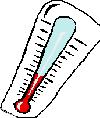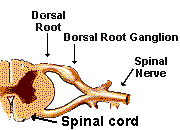What is Mercury?
 Mercury is a metal that has been used in products such as light bulbs,
batteries, paint and thermometers. Although quite useful, mercury is also
poisonous and can contaminate the environment if it is not disposed of
properly.
There are several forms of mercury:
Mercury is a metal that has been used in products such as light bulbs,
batteries, paint and thermometers. Although quite useful, mercury is also
poisonous and can contaminate the environment if it is not disposed of
properly.
There are several forms of mercury:
- Elemental (metallic) mercury: shiny, silver, odorless liquid used
in thermometers. It is absorbed by the body through vapors.
- Organic mercury: mercury combined with carbon. Methyl mercury is a
common form of organic mercury. These forms of mercury are soluble in
lipids and cross the blood brain barrier and placenta easily. Organic
mercury is absorbed through the digestive tract and also through
vapors.
- Inorganic mercury: mercury combined with non-carbon
substances. Mercury salts are one kind of inorganic mercury.
 Inorganic mercury is usually a white powder or crystals. This form of
mercury has been used in medicines. Mercuric nitrate was used by the
felt-hat industry in the process of curing felt. People in the felt-hat
industry sometimes showed signs of mercury poisoning and came down with
"Mad-Hatter" syndrome. The phrase "mad as a hatter" is often used to
describe people with strange behavior.
Inorganic mercury is usually a white powder or crystals. This form of
mercury has been used in medicines. Mercuric nitrate was used by the
felt-hat industry in the process of curing felt. People in the felt-hat
industry sometimes showed signs of mercury poisoning and came down with
"Mad-Hatter" syndrome. The phrase "mad as a hatter" is often used to
describe people with strange behavior.
Different types of mercury affect people in different ways. Organic
mercury is more dangerous than inorganic mercury, but many inorganic
mercury compounds can be converted to the organic type.
Where is Mercury Found?

- Mercury is a natural material found in the earth. Some mercury vapors
are given off during volcanic eruptions.
- Mercury is a by-product of coal-burning power plants. Mercury is
released into the air, then it falls back to the earth.
- Mercury is used by mining operations to separate gold from impurities
in ore.
- Mercury is used during the manufacture of various products. For
example, before 1990, mercury was added to paint.
How Are People Exposed to Mercury?
- Breathe mercury fumes.

- Eat food (especially fish) or drink water that has been contaminated
by mercury. Mercury is absorbed by fish through their gills. Mercury
also makes its way up the food chain when fish eat plankton or smaller
fish that are already contaminated. Fish that are commonly found with
high levels of mercury include shark, swordfish and large tuna. The
United States Food and Drug Administration has set a limit on the amount
of mercury (1 part per million) that cannot be exceeded in fish
intended for human consumption.
- Absorb mercury through the skin. Glass thermometers contain mercury
that should be cleaned up properly (see below).
- Eat objects that contain mercury. For example, small children may eat
batteries that contain mercury. Broken high power lights and long
fluorescent tubes can also contain mercury. Small amounts of mercury from
these sources may be ingested accidentally.
Mercury levels within a person's body can be measured in blood, urine and
hair samples. The normal level of mercury for someone who has not been
exposed to mercury is about 2 ppm (hair) or 3-4 ug/dl of blood or 25 ug/l
or urine. When levels get to about 50 ppm (hair), people may start to
experience nerve damage. Because hair continues to grow, it can be used
to document when and how much a person has been exposed to mercury.
How Does Mercury Affect the Nervous System?
Methyl mercury targets and kills neurons in specific areas of the nervous
system including the:
Visual
cortex
 |
Cerebellum
 |
Dorsal root ganglia
 |
Several mechanisms have been proposed to explain how mercury kills
neurons:
- Protein inhibition
- Disruption of mitochondria function
- Direct affect on ion exchange in a neuron
- Disruption of neurotransmitters
- Destruction of the structural framework of neurons
|
Methylmercury is especially dangerous to developing babies. This form of
mercury is highly toxic and can cross the placenta and the blood-brain barrier. Mercury is concentrated in the brain
of the developing fetus because the metal is absorbed quickly and is not
excreted efficiently. Children exposed to mercury may be born with
symptoms resembling cerebral palsy, spasticity and other movement
abnormalities, convulsions, visual problems and abnormal reflexes. The
brains of children who have died as a result of mercury poisoning show
neuron loss in the cerebellum and throughout the cerebral cortex.
Mercury also appears to affect brain development by preventing neurons
from finding their appropriate place in the brain. |
Human Brain
32 week old fetus

Image
courtesy of The Slice of Life |
Mercury Disasters
Several disasters have occurred when mercury found its way
into the food supply.
- Minamata Bay (Japan):
 Organic mercury was dumped
into Minamata Bay in the 1950s. Fish in the bay were contaminated and
about 2,000 people who ate these fish became poisoned. About 7% of the
children born to mothers who ate contaminated fish had neurological
problems. Symptoms in these children included uncoordinated movement,
abnormal reflexes, seizures and speech problems. Some adults also had
neurological problems such as visual disorders, shaking (tremors),
weakness, nausea, hearing loss, depression, confusion, loss of appetite
and memory problems. A total of 46 people died as a result of mercury
exposure. Organic mercury was dumped
into Minamata Bay in the 1950s. Fish in the bay were contaminated and
about 2,000 people who ate these fish became poisoned. About 7% of the
children born to mothers who ate contaminated fish had neurological
problems. Symptoms in these children included uncoordinated movement,
abnormal reflexes, seizures and speech problems. Some adults also had
neurological problems such as visual disorders, shaking (tremors),
weakness, nausea, hearing loss, depression, confusion, loss of appetite
and memory problems. A total of 46 people died as a result of mercury
exposure.
- Iraq: In 1972, approximately 6,500 people fell ill and 459 people died
after eating bread baked with wheat contaminated with a mercury-based
fungicide.
- Faroe Islands (North Atlantic): A study started in 1984 investigated
the effects of methyl mercury exposure on children born to mothers who ate
contaminated whale meat. Researchers found that children (seven years
old) who were born to mothers with a 10-20 ppm mercury count
had lower language, attention and memory scores than those children born
to
mothers with lower mercury levels. Interestingly, a study performed in
the Seychelles Islands (Indian Ocean) did not reveal any effects on
children born to mothers who had mercury hair levels of 10 ppm.
Can You Get Contaminated by Mercury if you Have Dental Fillings?
 Tooth cavities are most often filled with dental
amalgam. Dental amalgam is made with several different materials
including silver, tin, copper and mercury. When these materials are
combined, they form a stable substance. Used for over 150 years, dental
amalgam has proved to be an effective and relatively inexpensive way to
repair damaged teeth. Because dental amalgam contains mercury, some
people have been concerned that they can be poisoned by tooth fillings.
However, the American Dental
Association has reviewed the literature and has concluded that dental
amalgam is a safe way to repair teeth, unless you are allergic to one of
the materials in amalgam. The US EPA, Centers for Disease
Control and Prevention (CDC) and Food
and Drug Administration (with some uncertainty about the risk to specific groups) have reached similar conclusions.
Tooth cavities are most often filled with dental
amalgam. Dental amalgam is made with several different materials
including silver, tin, copper and mercury. When these materials are
combined, they form a stable substance. Used for over 150 years, dental
amalgam has proved to be an effective and relatively inexpensive way to
repair damaged teeth. Because dental amalgam contains mercury, some
people have been concerned that they can be poisoned by tooth fillings.
However, the American Dental
Association has reviewed the literature and has concluded that dental
amalgam is a safe way to repair teeth, unless you are allergic to one of
the materials in amalgam. The US EPA, Centers for Disease
Control and Prevention (CDC) and Food
and Drug Administration (with some uncertainty about the risk to specific groups) have reached similar conclusions.
How To Clean Up Mercury from a Broken Thermometer
- Take off any jewelry so you don't contaminate it.
- Scoop up the mercury with a sheet of cardboard.
- Place the mercury in a small bottle or vial.
- Cap the bottle or vial.
- Dispose of the bottle or vial properly. Many communities have
special hazardous waste disposals or pick-up locations.
- Wash your hands!
- NEVER use a vacuum cleaner to clean up mercury spills. A vacuum
cleaner will get contaminated and will
spread mercury vapors into the air.
|




 Mercury is a metal that has been used in products such as light bulbs,
batteries, paint and thermometers. Although quite useful, mercury is also
poisonous and can contaminate the environment if it is not disposed of
properly.
There are several forms of mercury:
Mercury is a metal that has been used in products such as light bulbs,
batteries, paint and thermometers. Although quite useful, mercury is also
poisonous and can contaminate the environment if it is not disposed of
properly.
There are several forms of mercury:

 Tooth cavities are most often filled with dental
amalgam. Dental amalgam is made with several different materials
including silver, tin, copper and mercury. When these materials are
combined, they form a stable substance. Used for over 150 years, dental
amalgam has proved to be an effective and relatively inexpensive way to
repair damaged teeth. Because dental amalgam contains mercury, some
people have been concerned that they can be poisoned by tooth fillings.
However, the American Dental
Association has reviewed the literature and has concluded that dental
amalgam is a safe way to repair teeth, unless you are allergic to one of
the materials in amalgam. The US EPA, Centers for Disease
Control and Prevention (CDC) and Food
and Drug Administration (with some uncertainty about the risk to specific groups) have reached similar conclusions.
Tooth cavities are most often filled with dental
amalgam. Dental amalgam is made with several different materials
including silver, tin, copper and mercury. When these materials are
combined, they form a stable substance. Used for over 150 years, dental
amalgam has proved to be an effective and relatively inexpensive way to
repair damaged teeth. Because dental amalgam contains mercury, some
people have been concerned that they can be poisoned by tooth fillings.
However, the American Dental
Association has reviewed the literature and has concluded that dental
amalgam is a safe way to repair teeth, unless you are allergic to one of
the materials in amalgam. The US EPA, Centers for Disease
Control and Prevention (CDC) and Food
and Drug Administration (with some uncertainty about the risk to specific groups) have reached similar conclusions.
![[email]](./gif/menue.gif)

